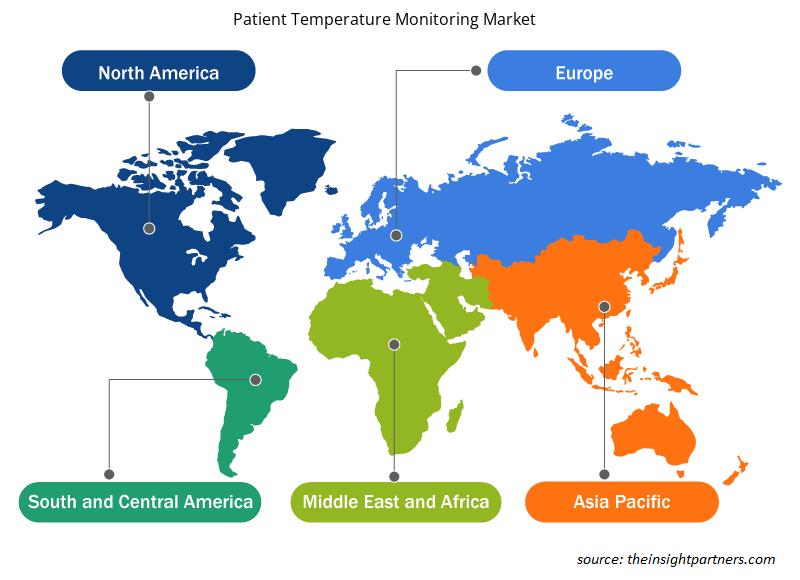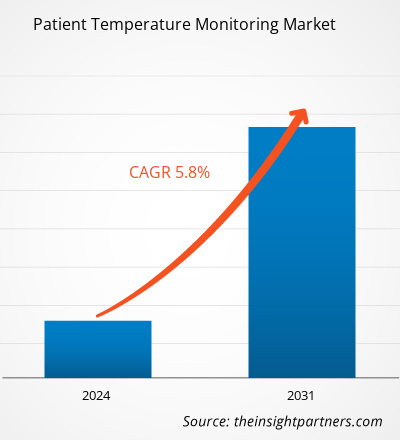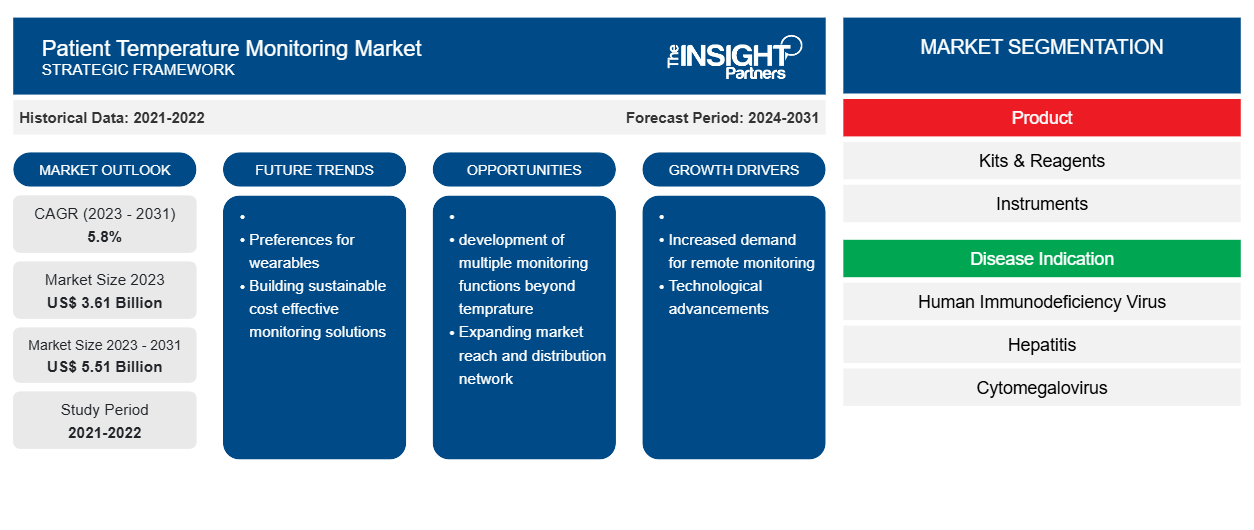Der Markt für die Überwachung der Patiententemperatur soll von 3,61 Milliarden US-Dollar im Jahr 2023 auf 5,51 Milliarden US-Dollar im Jahr 2031 anwachsen. Der Markt wird zwischen 2023 und 2031 voraussichtlich eine durchschnittliche jährliche Wachstumsrate von 5,8 % verzeichnen. Die zunehmende Verbreitung von Infektions- und chronischen Krankheiten, gefolgt von einem zunehmenden Bewusstsein für kontinuierliche Temperaturüberwachung und Vorsorge sowie einem wachsenden Fokus auf die Fernüberwachung von Patienten in Schwellenländern, werden wahrscheinlich weiterhin wichtige Trends auf dem Markt bleiben.
Marktanalyse zur Überwachung der Patiententemperatur
Ein Patiententemperaturüberwachungssystem ist ein medizinisches Gerät, das die Körpertemperatur eines Patienten kontinuierlich überwacht und so dem medizinischen Fachpersonal Echtzeitdaten liefert. Zu den Produkten gehören Thermistoren, Infrarotthermometer, digitale Thermometer und viele andere. Diese Produkte werden häufig in Krankenhäusern, Gesundheitseinrichtungen, Gesundheitseinrichtungen und bei häuslichen Pflegediensten eingesetzt. Schwankungen der Körpertemperatur eines Patienten sind eine Reaktion auf krankheitsspezifische Reize. Der menschliche Körper reguliert seine normale Temperatur, um den Abwehrmechanismus des Körpers zu unterstützen. Darüber hinaus weisen andere klinische Symptome der Temperaturüberwachung, wie Hyperthermie oder Hypothermie, das Vorhandensein einer Infektion und die Analyse antimikrobieller Behandlungen, eine erhebliche Bedeutung der kontinuierlichen Temperaturüberwachung auf. Diese Vorteile werden voraussichtlich die Einführung von Thermometern im Prognosezeitraum beschleunigen.
Marktübersicht zur Patiententemperaturüberwachung
Das Wachstum des Marktes wird einigen wichtigen treibenden Faktoren zugeschrieben, wie der zunehmenden Verbreitung von Infektions- und chronischen Krankheiten und dem wachsenden Bewusstsein für kontinuierliche Temperaturüberwachung und vorbeugende Pflege. Es wird jedoch geschätzt, dass die hohen Kosten für moderne Temperaturüberwachungsgeräte in Schwellenländern das Wachstum des Marktes in den Prognosejahren bis zu einem gewissen Grad behindern werden. Der globale Markt für Patiententemperaturüberwachung ist nach Regionen unterteilt in Nordamerika, Europa, Asien-Pazifik, Naher Osten und Afrika sowie Süd- und Mittelamerika. In Nordamerika sind die USA der größte Markt für Patiententemperaturüberwachung. Das Wachstum der Region wird auf eine steigende Nachfrage nach Patientenüberwachung und die zunehmende Verbreitung von Fieber und damit verbundenen Erkrankungen zurückgeführt.
Darüber hinaus wird erwartet, dass der zunehmende Fokus auf Technologiepartnerschaften und Vertriebskooperationen das Wachstum des Marktes für Patiententemperaturüberwachung in Nordamerika vorantreiben wird. Der asiatisch-pazifische Raum wird voraussichtlich das schnellste Wachstum auf dem Markt für Patiententemperaturüberwachung aufweisen. Ein zunehmendes Bewusstsein der Bevölkerung für chronische Erkrankungen und eine alternde Bevölkerung werden voraussichtlich den Markt für Patiententemperaturüberwachung im asiatisch-pazifischen Raum im Prognosezeitraum antreiben.
Passen Sie diesen Bericht Ihren Anforderungen an
Sie erhalten kostenlos individuelle Anpassungen an jedem Bericht, einschließlich Teilen dieses Berichts oder einer Analyse auf Länderebene, eines Excel-Datenpakets sowie tolle Angebote und Rabatte für Start-ups und Universitäten.
-
Holen Sie sich die wichtigsten Markttrends aus diesem Bericht.Dieses KOSTENLOSE Beispiel umfasst eine Datenanalyse von Markttrends bis hin zu Schätzungen und Prognosen.
Markttreiber und Chancen für die Patiententemperaturüberwachung
Wachsende Verbreitung von Infektionskrankheiten und chronischen Krankheiten
Gesundheitssysteme auf der ganzen Welt verzeichnen einen massiven Anstieg der Prävalenz von Infektionskrankheiten. Darüber hinaus verzeichnen chronische Erkrankungen wie Krebs, Diabetes und Herz-Kreislauf-Erkrankungen weltweit einen deutlichen Anstieg ihrer Prävalenz. Laut den Centers for Disease Control and Prevention (CDC) litten beispielsweise im Jahr 2019 fast 6 von 10 Menschen in den USA an mindestens einer chronischen Krankheit, und 4 von 10 Menschen hatten zwei oder mehr chronische Krankheiten. Die Messung der Körpertemperatur spielt bei der Beurteilung des Körperzustands eine wesentliche Rolle. Darüber hinaus sind Temperaturschwankungen ein wichtiger Faktor bei der Krankheitsdiagnose. Der Zusammenhang zwischen Temperaturschwankungen und dem Auftreten von Krankheiten wird voraussichtlich die Akzeptanz von Patiententemperaturüberwachungssystemen vorantreiben. Daher wird sich die Einführung von Patiententemperaturüberwachungssystemen in den kommenden Jahren wahrscheinlich beschleunigen.
Steigende F&E-Aktivitäten und Produkteinführungen
Die Akteure der Branche betreiben eine Vielzahl von F&E-Aktivitäten, um fortschrittliche Temperaturüberwachungssysteme zu entwickeln. Diese Technologiepartnerschaften werden im Prognosezeitraum voraussichtlich erhebliche Chancen für die Markteinführung neuer Produkte und die Einführung einer Vielzahl von Produkten bieten. So kündigte die Partnerschaft zwischen Bioclinica und VivaLNK im April 2020 die Einführung einer fortschrittlichen Fernüberwachung der Körpertemperatur von Patienten für klinische Studien an. Nach Angaben der Unternehmen soll die Lösung umfassende Daten zur Körpertemperatur des Patienten von jedem entfernten Standort aus liefern, sei es zu Hause oder in einer Forschungseinrichtung. Daher wird erwartet, dass die zunehmende Zahl der F&E-Aktivitäten in Verbindung mit der wachsenden Zahl von Virusausbrüchen auch das Marktwachstum im Prognosezeitraum vorantreiben wird. So brachte beispielsweise Aranet, ein Hersteller von drahtlosen Sensoren für das IoT, im April 2020 ein fortschrittliches Temperaturüberwachungssystem auf den Markt, um der zunehmenden Zahl von COVID-19-Fällen auf der ganzen Welt gerecht zu werden.
Marktbericht zur Patiententemperaturüberwachung – Segmentierungsanalyse
Wichtige Segmente, die zur Ableitung der Marktanalyse zur Patiententemperaturüberwachung beigetragen haben, sind Produkttyp, Standort und Anwendungen.
- Nach Typ ist der Markt für die Überwachung der Patiententemperatur in tragbare Sensoren zur kontinuierlichen Überwachung, intelligente Temperaturüberwachungspflaster, Tischgeräte zur Temperaturüberwachung, tragbare Temperaturüberwachungsgeräte und invasive Temperaturüberwachungsgeräte unterteilt. Das Segment der tragbaren Sensoren zur kontinuierlichen Überwachung hatte 2023 den größten Marktanteil.
- Nach Standorten ist der Markt in nichtinvasive Temperaturüberwachung und invasive Temperaturüberwachung segmentiert. Das Segment der nichtinvasiven Temperaturüberwachung hatte im Jahr 2023 den größten Marktanteil.
- In Bezug auf die Anwendung ist der Markt in Pyrexie/Fieber, Hypothermie, Bluttransfusion, Anästhesie und andere Anwendungen unterteilt. Das Segment Pyrexie/Fieber hielt im Jahr 2023 einen erheblichen Marktanteil.
Marktanteilsanalyse zur Patiententemperaturüberwachung nach geografischer Lage
Der geografische Umfang des Marktberichts zur Patiententemperaturüberwachung ist hauptsächlich in fünf Regionen unterteilt: Nordamerika, Asien-Pazifik, Europa, Naher Osten und Afrika sowie Süd- und Mittelamerika. Nordamerika hat den größten Marktanteil am Markt für Patiententemperaturüberwachung nach geografischer Lage. Die USA sind der größte Markt für Patiententemperaturüberwachung. Das Wachstum dieses Marktes wird in erster Linie durch die zunehmende Verbreitung chronischer und infektiöser Krankheiten, eine wachsende Anzahl von Produkteinführungen durch wichtige Akteure und einen zunehmenden Fokus auf vorbeugende Maßnahmen zur Bekämpfung der Krankheitsprävalenz und Patientenüberwachung bestimmt. Technologische Fortschritte haben die sichere und wirksame Verwaltung der vorbeugenden Pflege zu Hause verbessert.
Darüber hinaus können diese Geräte Informationen von jedem beliebigen entfernten Standort aus bereitstellen. Diese Faktoren werden voraussichtlich den US-Markt ankurbeln. Der asiatisch-pazifische Raum wird in den kommenden Jahren voraussichtlich die höchste durchschnittliche jährliche Wachstumsrate aufweisen.
Regionale Einblicke in den Markt für Patiententemperaturüberwachung
Die regionalen Trends und Faktoren, die den Markt für Patiententemperaturüberwachung während des gesamten Prognosezeitraums beeinflussen, wurden von den Analysten von Insight Partners ausführlich erläutert. In diesem Abschnitt werden auch die Marktsegmente und die Geografie der Patiententemperaturüberwachung in Nordamerika, Europa, im asiatisch-pazifischen Raum, im Nahen Osten und Afrika sowie in Süd- und Mittelamerika erörtert.

- Erhalten Sie regionalspezifische Daten zum Markt für Patiententemperaturüberwachung
Umfang des Marktberichts zur Patiententemperaturüberwachung
| Berichtsattribut | Details |
|---|---|
| Marktgröße im Jahr 2023 | 3,61 Milliarden US-Dollar |
| Marktgröße bis 2031 | 5,51 Milliarden US-Dollar |
| Globale CAGR (2023 - 2031) | 5,8 % |
| Historische Daten | 2021-2022 |
| Prognosezeitraum | 2024–2031 |
| Abgedeckte Segmente |
Nach Produkt
|
| Abgedeckte Regionen und Länder |
Nordamerika
|
| Marktführer und wichtige Unternehmensprofile |
|
Dichte der Marktteilnehmer zur Überwachung der Patiententemperatur: Die Auswirkungen auf die Geschäftsdynamik verstehen
Der Markt für Patiententemperaturüberwachung wächst rasant, angetrieben durch die steigende Endverbrauchernachfrage aufgrund von Faktoren wie sich entwickelnden Verbraucherpräferenzen, technologischen Fortschritten und einem größeren Bewusstsein für die Vorteile des Produkts. Mit steigender Nachfrage erweitern Unternehmen ihr Angebot, entwickeln Innovationen, um die Bedürfnisse der Verbraucher zu erfüllen, und nutzen neue Trends, was das Marktwachstum weiter ankurbelt.
Die Marktteilnehmerdichte bezieht sich auf die Verteilung der Firmen oder Unternehmen, die in einem bestimmten Markt oder einer bestimmten Branche tätig sind. Sie gibt an, wie viele Wettbewerber (Marktteilnehmer) in einem bestimmten Marktraum im Verhältnis zu seiner Größe oder seinem gesamten Marktwert präsent sind.
Die wichtigsten auf dem Markt für Patiententemperaturüberwachung tätigen Unternehmen sind:
- 3M
- Amerikanische Diagnosegesellschaft
- Kardinal Health Inc.
- Drägerwerk AG & Co. KGaA
- OuraAva Science Inc.
- Tempdrop LLC.
Haftungsausschluss : Die oben aufgeführten Unternehmen sind nicht in einer bestimmten Reihenfolge aufgeführt.

- Überblick über die wichtigsten Akteure auf dem Markt für Patiententemperaturüberwachung
Marktnachrichten und aktuelle Entwicklungen zur Patiententemperaturüberwachung
Der Markt für Patiententemperaturüberwachung wird durch die Erhebung qualitativer und quantitativer Daten aus Primär- und Sekundärforschung bewertet, die wichtige Unternehmenspublikationen, Verbandsdaten und Datenbanken umfasst. Nachfolgend sind einige der Entwicklungen auf dem Markt für Patiententemperaturüberwachung aufgeführt:
- Adventist Health Hanford hat kürzlich das Temperaturmanagementsystem IQoolTM erworben, eine innovative Technologie, die bei klinischer Indikation eine Hypothermiebehandlung für Patienten ermöglicht. Das IQool™-System verwendet gezieltes Temperaturmanagement (TTM), um die Körpertemperatur der Patienten zu überwachen und automatisch bei 32 °C bis 39 °C zu halten. (Quelle: Adventist Health, Pressemitteilung, Mai 2024)
- Das in Dallas ansässige Medizintechnikunternehmen SpotSee hat TempMonitor auf den Markt gebracht, einen einfachen und erschwinglichen Temperaturindikator zur Einmalverwendung für Patienten, die auf Insulin und Glucagon-ähnliche Peptid-1-Medikamente (GLP-1) angewiesen sind. Durch die Verwendung von TempMonitor können Patienten beruhigt sein, da sie wissen, dass ihre Medikamente innerhalb des empfohlenen Temperaturbereichs gelagert und transportiert werden. (Quelle: Cipla, Pressemitteilung, April 2024)
Marktbericht zur Überwachung der Patiententemperatur – Umfang und Ergebnisse
Der Bericht „Marktgröße und Prognose zur Patiententemperaturüberwachung (2021–2031)“ bietet eine detaillierte Analyse des Marktes, die die folgenden Bereiche abdeckt:
- Marktgröße und Prognose zur Patiententemperaturüberwachung auf globaler, regionaler und Länderebene für alle wichtigen Marktsegmente, die im Rahmen des Berichts abgedeckt sind
- Markttrends zur Überwachung der Patiententemperatur sowie Marktdynamiken wie Treiber, Einschränkungen und wichtige Chancen
- Detaillierte PEST/Porters Five Forces- und SWOT-Analyse
- Marktanalyse zur Patiententemperaturüberwachung, die wichtige Markttrends, globale und regionale Rahmenbedingungen, wichtige Akteure, Vorschriften und aktuelle Marktentwicklungen umfasst
- Branchenlandschaft und Wettbewerbsanalyse, die die Marktkonzentration, Heatmap-Analyse, prominente Akteure und aktuelle Entwicklungen auf dem Markt für Patiententemperaturüberwachung umfasst
- Detaillierte Firmenprofile
- Historische Analyse (2 Jahre), Basisjahr, Prognose (7 Jahre) mit CAGR
- PEST- und SWOT-Analyse
- Marktgröße Wert/Volumen – Global, Regional, Land
- Branchen- und Wettbewerbslandschaft
- Excel-Datensatz
Aktuelle Berichte
Verwandte Berichte
Erfahrungsberichte
Grund zum Kauf
- Fundierte Entscheidungsfindung
- Marktdynamik verstehen
- Wettbewerbsanalyse
- Kundeneinblicke
- Marktprognosen
- Risikominimierung
- Strategische Planung
- Investitionsbegründung
- Identifizierung neuer Märkte
- Verbesserung von Marketingstrategien
- Steigerung der Betriebseffizienz
- Anpassung an regulatorische Trends























 Kostenlose Probe anfordern für - Markt für die Überwachung der Patiententemperatur
Kostenlose Probe anfordern für - Markt für die Überwachung der Patiententemperatur